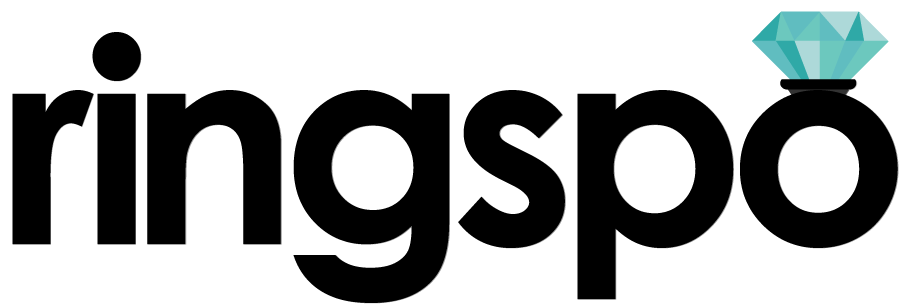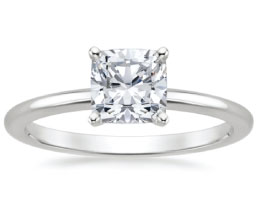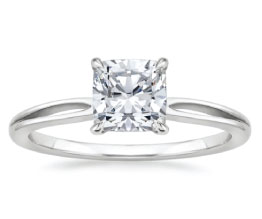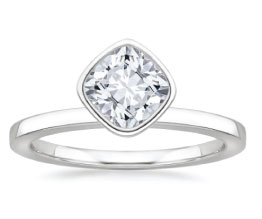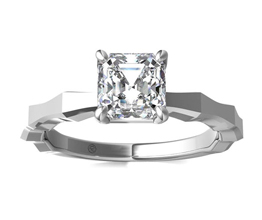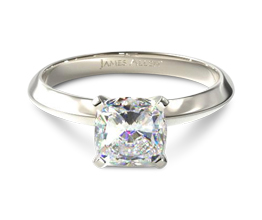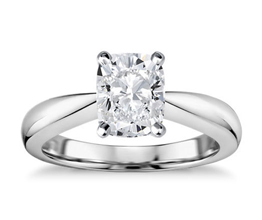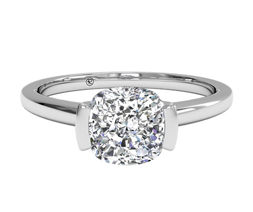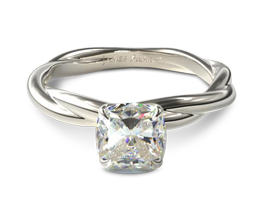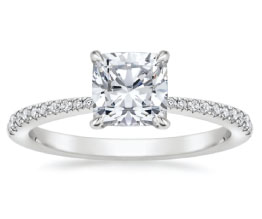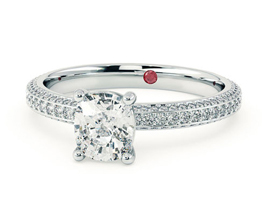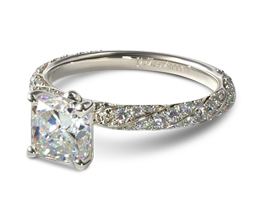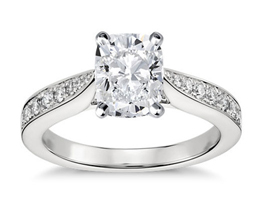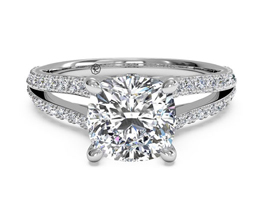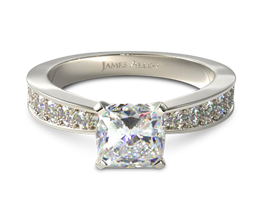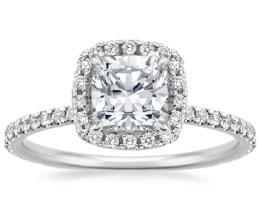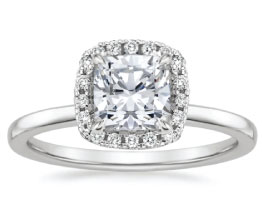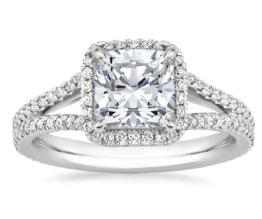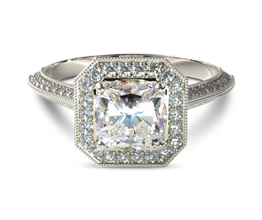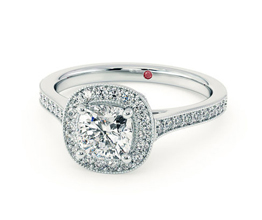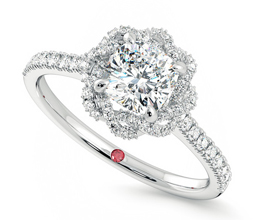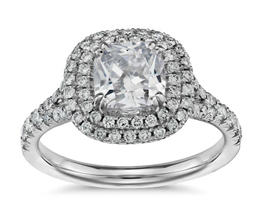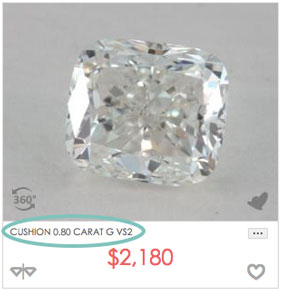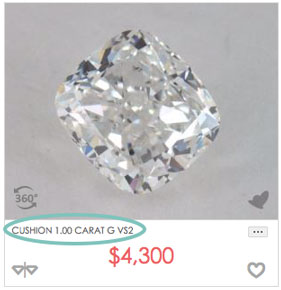Cushion cut engagement rings
How to get the best cushion cut diamond for your budget
Ringspo is reader supported
Ringspo is reader-supported, which means we may receive a commission if you click a link to a retailer & subsequently make a purchase.
We feature links to several retailers to help readers find the one that is the best fit for them. Find out more about how Ringspo works here.
Cushion cut engagement rings are a classic shape that are making a comeback, as more people realise that they offer a great combo of elegant style, incredible sparkle and great value.
Do you know about the 4Cs?
Much of the information on this page will focus on diamonds, as getting that right is key to getting an awesome ring for a great price. If you’re not familiar with the 4Cs of diamonds then I’d recommend reading this page which gives an overview of what you really need to know.
What is a cushion cut diamond?
Cushion cut diamonds have been around for a couple of hundred years and until the round brilliant came on the scene in the early 1900s were the default choice for diamonds. A large number of vintage rings will therefore have a cushion cut stone as their center stone.
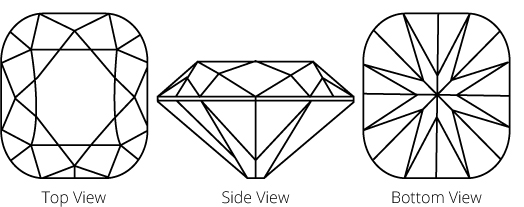
They fell out of favour when the round brilliant shape was created and people chose it for its superior sparkle.
But today’s cushion cut diamonds have learnt from their newer, flashier brothers. Modern cushion cuts have taken the learnings of the past century on how light is reflected through ‘brilliant’ cut diamonds to increase its sparkle way beyond what you would find in a ring from 100 years ago.
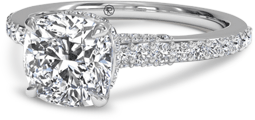
This has resulted in cushion cuts being one of the most confusing types of diamond out there due to the high number of variations on the shape. As people have tweaked and modified the shape of the cushion cut in its long and storied history, many different shapes and even names have been created.
Cushion cut diamonds come in many variations
This section gets a bit detailed, so if you’re not super into details then feel free to skip to the next section.
Maybe the first thing to clear up is that cushion cuts and ‘pillow’ cuts are one and the same thing – you may hear the two terms used interchangeably. But there are also other terms that you might hear while looking at rings: modified cushions, crushed ice, broken glass, old miner cuts and many more. These all basically refer to modifications to the classic shape and the looks that result from the modification.
These can broadly be categorised into two main groups, and which type of cushion that you are looking at will be noted on the grading report that will accompany the stone:
- Cushion brilliant cut – with 58 facets, the diamond has been cut similarly to a round brilliant diamond
- Cushion modified brilliant cut – facets have been either added or taken away to try improve appearance and ‘optical performance’ (how light is reflected back to your eyes) of the stone.
There’s a large variety of different shapes that all fall under the umbrella of ‘cushion cut’, depending on the number of facets of the stone, including the below:

To add to the confusion, there are two other distinctions that people make with cushion cut diamonds – calling them either ‘chunky’ or ‘crushed ice’. These two terms refer to the look of the stone when viewed from above.
‘Chunky’ cushion cut diamond
When you look through the top table of the stone (the flat part on top), you can see the facets line up, often making the shape of an ‘X’ that meets in the middle.
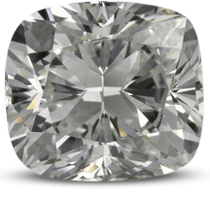
‘Crushed ice’ cushion cut diamond
When you look through the top table of the stone, the facets are organized randomly – there’s no X in the center of the stone. Instead, it looks like crushed ice, or it’s also sometimes called ‘broken glass’..
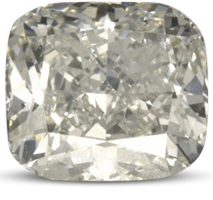
Neither a chunky cushion nor a crushed ice cushion are necessarily better than the other – it’s down to your personal preference.
And there’s no hard and fast rules on what produces a chunky cushion and what produces a crushed ice stone. It’s sometimes said that a classic cut cushion diamond will give you a chunky cushion and a modified will give you a crushed ice, but this isn’t always true. The only way to see which look you will get is to examine the individual diamond that you are going to buy, and the best way to do that is to look at a retailer’s selection of cushion cut diamonds to see what you like.
One other thing to know is that when the diamond is actually mounted in an engagement ring, it is much, much more difficult to tell the difference between the different variations than when looking at a magnified image of the diamond on its own, like in the pictures above.
It’s great to be informed and to know what it is that you’re buying, but don’t get too caught up in the details – the number of facets and the profile on the underside of your cushion cut diamond will make very little difference to the final appearance of your ring.
What’s good about cushion cut engagement rings?
Cushion cut diamonds are well-priced
As with many square-shaped diamonds, a big tick in the box for cushion cuts for engagement rings is their lower price than the much more common ’round brilliant’ shape.
Cushion cut diamonds are in lower demand, but also result in less wastage of the original rough diamond in their manufacture, so a larger finished gem can be created from a piece of rough stone.
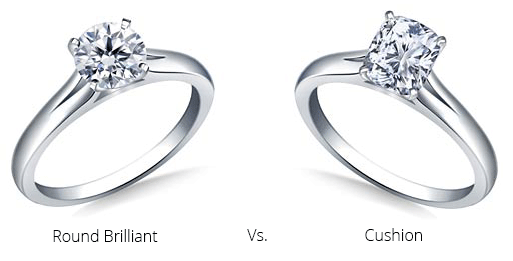
Cushion cuts are also a slightly simpler shape to create than some others, so less technical expertise and time is required, which results in lower labour costs which can be passed on to you, the end consumer.
This table shows the price difference between a round brilliant diamond and a cushion cut diamond at the same size and quality when the prices were compared on one of our recommended retailers.
- 1 carat
- Color F
- Clarity VS1
Here’s how they stack-up:
| SHAPE | PRICE (US$) | DIFFERENCE (US$) | DIFFERENCE (%) |
| Round Brilliant | 6,610 | ||
| Cushion | 4,109 | -2,501 | -37.8 |
So, for the same size and quality of stone, you can save yourself a huge 38% by choosing a cushion over the more common round brilliant shape.
Changing the size, colour and quality of the stone will give different amounts saved, but there will always be a significant difference between the two.
Cushion cut diamonds are practical
Cushion cut diamond engagement rings don’t have any sharp edges or corners because of their rounded shape, which makes them ideal for a ring that is going to be worn every day. There are no points to snag in clothing or exposed and delicate edges which are liable to be chipped.
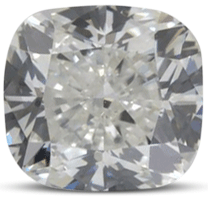
Cushion cut diamonds are elegant
Lastly, cushion engagement rings are a classic and elegant style, while still giving excellent sparkle – the best of both worlds.
What’s bad about cushion cut engagement rings?
Cushion cut diamonds sparkle slightly less than some other shapes
The biggest drawback of the cushion cut compared to the much more common round brilliant, or even the Princess or radiant cuts, is that it doesn’t quite have the same level of brilliance in its sparkle.
Where it makes up for it slightly is in its ‘fire’, which is a measure of how a diamond reflects and disperses coloured light, but if you’re looking for the sparkliest, blingiest stone out there then the cushion probably isn’t the one for you.
Cushion cut diamonds look slightly smaller than some other shapes
Cushion cuts also ‘face up’ smaller than some other shapes of diamond, which means that they look slightly smaller when viewed from the top. This is because as they are cut deeper carry more of their weight under the ‘girdle’ of the stone ie. on the bottom, where it can’t be seen.
The images below show the difference in size between a one carat round brilliant diamond and a one carat cushion cut stone – the cushion cut does definitely appear slightly smaller.
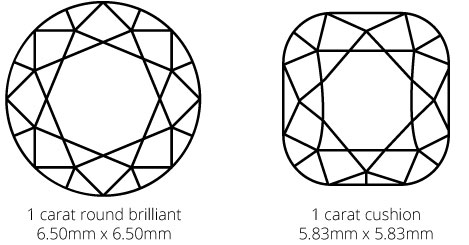
Every cushion cut diamonds each need to be examined
Due to the variation in shape, cushion cut diamonds are a bit more difficult to buy than some of the other, more common diamond shapes.
While with a round diamond you can check out the 4Cs listed on the grading certificate and trust the stats to ensure that you are getting a great looking rock, because each cushion cut diamond is different, you really do need to examine the individual stone to check that you like its shape, know whether it is chunky or crushed ice and verify that it is eye clean.
This means that some online retailers which don’t offer images of each individual stone shouldn’t be used when purchasing a cushion cut engagement ring. Even if they offer the most competitive price, it’s worth going with a retailer that allows you to examine the individual stone to make sure that it’s right for you.
Recommended retailers that have great images of their cushion cut diamonds are:
Cushion cuts can be more difficult to trade in
While you may not be thinking about it right now, many people end up ‘upgrading’ their diamond ring at some point during the course of their marriage – often to mark a significant anniversary. In the future, if you’re looking for the best place to sell engagement ring, it may simply be the place that is willing to take a chance on buying a cushion cut diamond.
Cushion cut engagement ring settings
The ring setting you choose is the biggest factor in how the ring actually looks once it’s being worn. Sure, the shape of the diamond, the quality of the stone and the resultant level of brilliance and sparkle make a difference, but it’s really the format of the stone, metal band and any supporting stones determines what the ring really looks like.
The list below is definitely not a definitive list of all of the different setting styles that are out there for cushion cut engagement rings, but it’s intended to give you an idea of what is out there and what a cushion cut diamond looks like in some of the more classic and common setting styles.
Although I’ve only included white metal coloured settings, most of these settings are also offered in yellow gold and rose gold too.
To find out more about any style, click through and explore on the retailer’s website. Each retailer will have many other cushion cut ring styles for you to check out as well.
Cushion cut solitaire engagement rings
A classic 4 prong setting is great for a cushion cut because it allows as much light as possible to enter the stone, giving the diamond the best chance possible of sparkling.
Scroll across to check out a selection of cushion cut solitaire engagement ring options, and click through to find out more about each one.Scroll across to check out a selection of cushion cut solitaire engagement ring options, and click through to find out more about each one.
[
Cushion cut pavé engagement rings
A pavé setting is one where the ring band is ‘paved’ with smaller stones. It’s a great way to add some extra sparkle to a ring, while retaining a simple format.
One thing to watch out for with pavé settings is that the ‘Total Carat Weight’, or CTW, may be quoted. This is the total weight of all the stones in the ring – both the center stone and all of the smaller stones that make up the pavé. If you’re going to go for a pavé setting, ensure you know the carat weights for both the center stone on its own AND the total weight.
Cushion cut diamond halo engagement rings
Another popular setting that maximises the bling factor is cushion cut halo engagement ring setting, which surround the center stone with a large number of smaller stones
The halo is a great way of upping the bling and increasing the impressiveness of a ring, and the increase in the cost of the setting over a simpler ring can often be offset by using a slightly smaller center stone than would be needed in, say, a solitaire setting.
Cushion cut diamond buying guide
Although cushion cuts are definitely getting more popular, finding a high quality stone is still more difficult than other ‘fancy’ shapes e.g. the Princess cut. If you’re starting out by looking in your local bricks and mortar store, it’s likely that their selection will be pretty limited.
You’re more likely to find cushion cut stones in vintage rings, or the related ‘old mine cut’. One thing to note with vintage rings is that a ‘warmer’ colour was more popular when most vintage rings were created, so the stones are likely to look more yellow than a modern cut stone. For a guide to buying vintage rings, check out this post.
In this next section you’ll learn what to look for to make sure that you get a great stone for your ring, with detailed recommendations for each of the 4 Cs.
International cushion cut guides
Each country has its own retailers we’ve therefore created individual guides for different countries. If you live outside the US, click below to access your local guide:
Cushion cut diamond color
Cushion cut diamonds display their true color more than other diamond shapes that are better optimised for sparkle – the Princess and round brilliant cuts allow you to go further down the colour scale without the stone appearing noticeably yellow. I recommend that you go to color G as a minimum if you are going for a white colour setting, or J if you are going for a gold setting, which disguises the warm color better.
Colors at the top end of the colour scale (colours D and E) are very difficult to tell apart from each other and are really chosen for prestige rather than any actual benefit when the stone is viewed. You can definitely go for a D or an E color if you want to go for the highest grade possible, but the actual benefit over an F or even a G will be minimal once the stone is set in a ring and actually being worn.
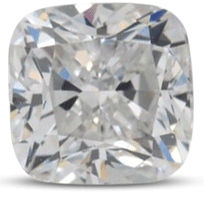
Very white

A good balance between colour and value
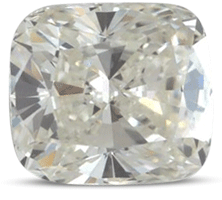
Yellow tones clearly visible
Cushion cut diamond clarity
With cushion cuts, you can pretty much trust the grading report, as long as you are going with one of my two recommended certification labs – GIA or AGS.
Anything down to VS2 should be eye-clean, and the sparkle that the stone offers should work to hide any minor imperfections. Again, you can go higher than this if you want, but you are paying for a stone that is ‘mind clean’ rather than one that has any noticeable visual difference.

If you are considering going with a stone at SI2 or lower then you should definitely use a retailer that provides you with high quality, magnified pics of the exact stone that you are considering purchasing. This will allow you to check that no flaws are present in the stone. James Allen and Brian Gavin both have excellent photography of their cushion cut stones.
One thing to note is that ‘crushed ice’ stones are more likely to hide the presence of minor flaws than chunky cushion cuts, as the tiny flaws are lost in the random facets. Again, the only way to tell whether this is the case, and which type you are going to get, is to examine magnified photos, rather than relying on the 4Cs on the grading report.
Cushion cut diamond cut quality
Unlike the round brilliant stone, there are no set ‘ideal’ proportions for a cushion cut stone. However, there are a couple of things to bear in mind to ensure that you get a stone that looks like you want it to and that it sparkles as much as possible.
Cushion cut length : Width ratio
The length : width ratio is, unsurprisingly, the ratio between the width and the length of a stone and for a perfect square, this would be 1:1 – the length and width equal.
Traditional cushion cuts were square, so if this is the look that you want then you should aim to get as close to a 1:1 L/W ratio as possible. An exact ration of 1:1 is rare though, and you can got up to 1:1.05 without the stone looking noticeably rectangular once it’s set in a ring.

While other traditionally square cuts like the Princess don’t have a rectangular equivalent, and a rectangular version of the Asscher cut is the emerald cut, with cushion cuts, a stone with a higher length / width ratio is just known as a rectangular cushion cut. Any stone between 1.15 and 1.3 is a rectangular cushion cut, and although they weren’t the original cushion shape, rectangular cushions are now popular than square. So, if you like the look of them then go for it.
Corner shape
Nothing on the certificate will tell you how rounded the corners are: some cushion cut diamond corners are nearly round, and some are nearly square. Even on the examples used in the ‘color’ section above, you can see a variation in the straightness of the sides of the stones and the sharpness of the corners. Again, the only want to know what the stone that you are looking at will really look like is to use a jeweler who offers clear magnified pictures of the stone you’re interested in.
There are also two primary characteristics you want to pay attention to when looking at proportions. These are depth percentage and table size which are both expressed as percentages in a grading report.
Depth Percentage
Depth percentage is the depth as a percentage of the width of the stone.
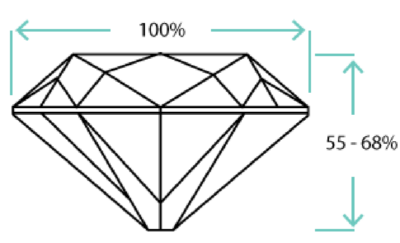
This is super important as the correct proportions are required to make sure as much light is reflected back to your eye and the stone sparkles as much as possible.
My recommendations to ensure that the most light possible is reflected back is:
| Excellent | Very good | Good |
|---|---|---|
| 55% – 68% | 52% – 72% | 50% – 76% |
Cushion cut diamond table percentage
Table percentage is the width of the top ‘table’ of a diamond (the flat are on top) expressed as a percentage of the total width of the stone. Again this is an important ratio because the proportions here will affect how light is reflected within the stone and therefore how much is reflected back to your eyes, making the diamond sparkle.
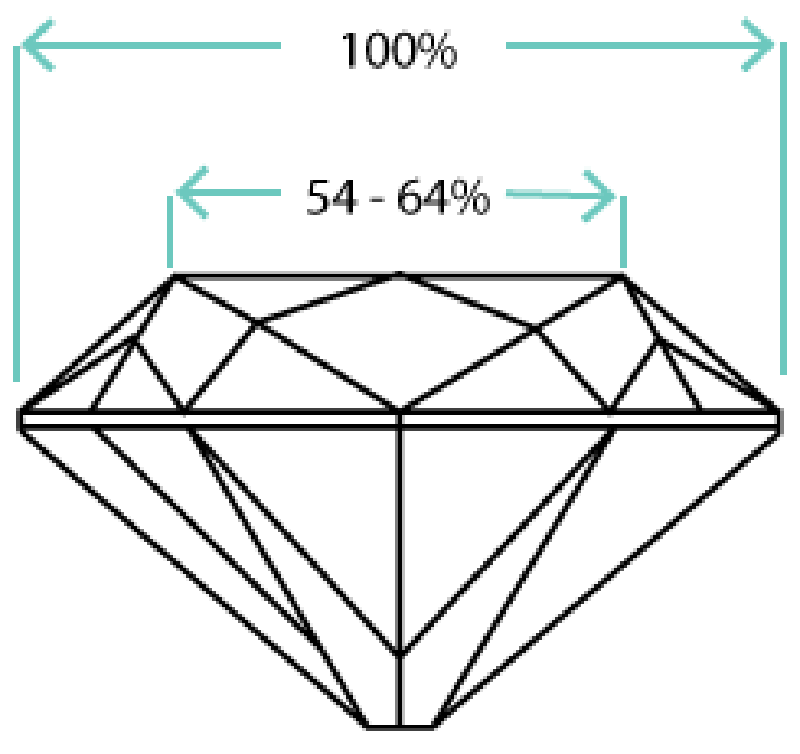
Recommendations for cushion cut table % are below:
| Excellent | Very good | Good |
|---|---|---|
| 54% – 64% | 52% – 66% | 60% – 68% |
Symmetry
One further cut factor to consider with cushion cut diamonds is symmetry, and if your budget stretches to it then we recommend going for either ‘very good’ or ‘excellent’, especially if it’s a ‘chunky’ cushion cut. This will make it more likely that the facets line up visually and look good when viewed from above, and will also mean that the stone is likely to reflect as much light as possible back to your eyes – making it sparkle.
One jeweler who has taken this to the limit is Brian Gavin, who has created a signature ‘Hearts and arrows’ cushion cut. This basically means that the stone have perfect symmetry which can be seen when the stones are viewed through special gemologist optical tools using certain wavelengths of light. The results are a series of ‘hearts’ and ‘arrows’ which can only be created by the facets of the diamond lining up perfectly and being incredibly symmetrical all the way around the stone.
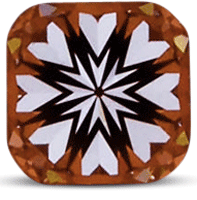
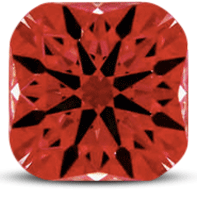
They are undoubtedly the highest quality cushions out there and worth looking at if you want to make sure that you are getting the best. You can check out their range of Hearts and Arrows cushion cut diamonds here.
Cushion cut diamonds carat weight
Carat weight is something that people often get overly hung-up on. They want to choose a stone with a certain carat weight, even if it means that they end up making sacrifices on other, more important attributes of the ring.
The relationship between a diamond’s carat weight and its visible size isn’t always a direct one. When we judge a diamond’s size, we look at it from the top – known as the ‘face up’ position in the jewelry trade. However, much of the weight of a diamond is actually carried on the bottom half of the stone, where it can’t be seen.
The images below show the difference in size for cushion cut diamonds at a range of carat weights:
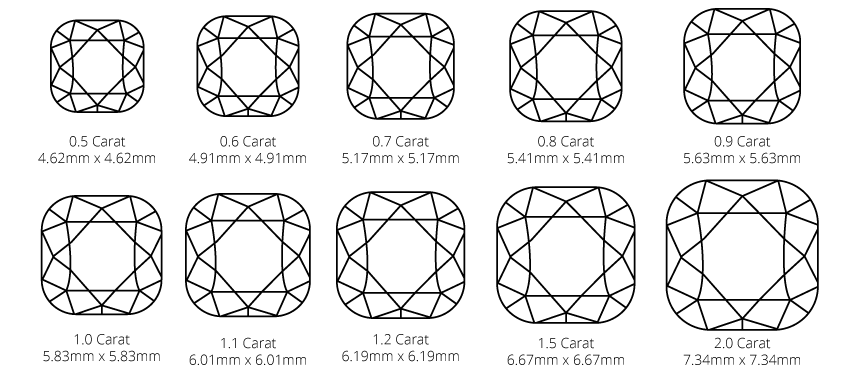
Hopefully you can see that increasing the carat weight doesn’t necessarily translate into a much visibly larger diamond. Changing the size from 0.8 carat to 1 carat is an increase in width of just over 0.4mm – less than 10%. However, the difference in price will be much more significant – nearly a 100% increase:
Diamond prices do fluctuate over time, so it may be worthwhile for you to check the difference in prices between a 0.8 carat and a 1 carat cushion cut today, which you can do here.
The priority that you place on diamond carat weight and how bit you want to go is totally up to you. However, my recommendation is that you definitely don’t make it the most important attribute when choosing your engagement ring. Get the setting you love, find a diamond with a great cut that is going to sparkle brilliantly, make sure that it is eye-clean and has a good color and then see what carat weight you can fit into your budget.
A well-rounded diamond with excellent sparkle will much much more impressive than a big stone with obvious flaws.
Cushion cut diamond certification
The fifth C, and a very important one too. When looking at any diamond, you need to ensure that any diamond that you’re looking at is a ‘cert stone’, which means that it has been assessed, graded and coded with a laser by an independent lab.
Each certificate has a unique report number and detailed information about the stone, covering the four Cs, the height, depth and other info. As well as providing assurance that the stone that you’re buying is the quality that you are paying for, a certificate also proves what you’re buying is not a substitute.
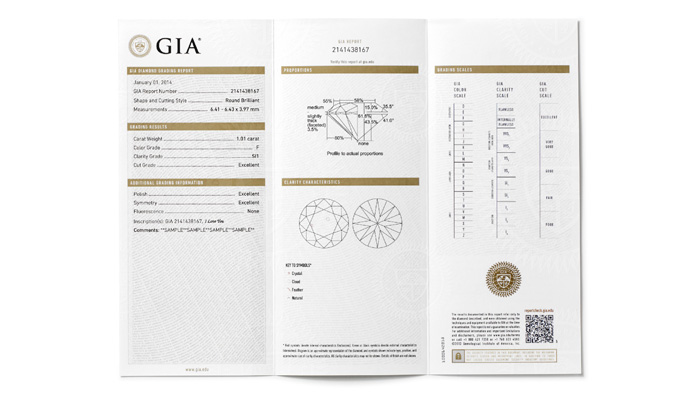
The lab to trust and to look for certification from is the non-profit Gemological Institute of America (GIA). It’s the most internationally recognised and generally seen as the most impartial of all of the gem labs.
The reason that the GIA is so well respected is because most others labs are part of trade bodies that contain jewelry retailers, or are ‘for profit’. While the GIA is very consistent with its gradings, the others have a reputation for being overly generous. What the GIA say is merely a diamond with a ‘good’ cut, maybe be graded ‘excellent’ by another lab, with an excellently large price to match.
Diamond certificates are what makes buying online safe and the best way to get a fantastic diamond at the lowest price. Knowing that each diamond you’re considering has been measured and graded by independent experts allows you to make an informed decision. You can take your time to consider the differences between diamonds and make sure you choose what experts have graded as the best stone, meaning that you get your perfect engagement ring at the best possible price.
International cushion cut guides
Each country has its own retailers we’ve therefore created individual guides for different countries. If you live outside the US, click below to access your local guide:
Recommended cushion cut diamond specs
These specs are the minimum that we recommend to ensure that the diamond on your cushion cut engagement ring looks fantastic.
You can of course go higher than these specs, if your budget allows, but for many of the characteristics you are paying for improvements that are very difficult, if not impossible, to see by the naked eye, especially when mounted in a ring setting.
Clarity: SI1
Colour: G
Symmetry: Excellent
Table %: 54% – 64%
Depth %: 55% – 68%
L/W Ratio: 1.05 or under, if you want a square stone
